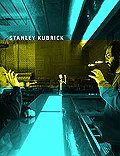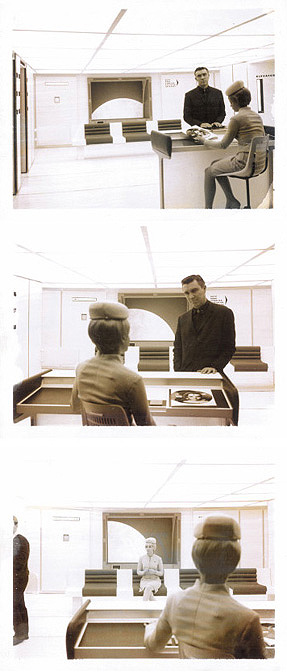[Original works from the Stanley Kubrick Estate.
Stanley Kubrick and Geoffrey Unsworth developed a system for calculating from the grey tones of b/w Polaroids the right lighting for filming
2001: A SPACE ODYSSEY.]
Kubrick on view - Catalogue
¬ Exhibition concept
¬ Catalogue
¬ Museums
¬ Stations
¬ Loans

The catalogue accompanying the exhibition Stanley Kubrick brings together essays by authors
from the fields of film and theater studies, art history, photography, architecture, design,
and music. The book offers interdisciplinary essays while also addressing each of Kubrick's
films, which are analyzed from different angles. Interviews as well as pictures and documents
from the estate add to the essays, and a detailed filmography and discography
complete the publication.
With words of greeting from
Martin Scorsese und
Christiane Kubrick and a preface by
Jan Harlan.
The catalogue is published in an English and a German version. It is available either at the
counter of Deutsches Filmmuseum and during the exhibition in Berlin at the counter of the Martin-Gropius-Bau
and in the bookshop Walther König or via
internet.
Catalogue "Stanley
Kubrick" (english). Kinematograph no. 20, 2004, 304 pages with many illustrat.
ISBN 3-88799-069-2 (english version), € 30,-. Order >>>
¬ Order
form as PDF file
Alexandra von Stosch and Rainer Crone start off the catalogue with a reflection
on the photographic work of young Kubrick, while Bernd Kiefer provides a comparative
study of the early films. Wilhelm Roth explains the political discussions around PATHS
OF GLORY, while Winfried Günther assesses Kubrick's visual handwriting in the
"commissioned" work SPARTACUS, and Sabine Nessel pursues the question "How did they
ever make a movie of Lolita?" Boris Hars-Tschachotin investigates the War Room in DR.
STRANGELOVE OR: HOW I LEARNED TO STOP WORRYING AND LOVE THE BOMB and provides an
extensive interview with Ken Adam while Daniel Kothenschulte presents Weegee's
photographs from the film's set. Design and branding in 2001: A SPACE ODYSSEY are the
themes examined by Volker Fischer and Bernd Eichhorn respectively; Kubrick's longtime
assistant Anthony Frewin contributes information about a prologue cut out of the film.
Thomas Elsaesser in his essay presents Kubrick as an "evolutionary engineer of images"
with a specific reference to A CLOCKWORK ORANGE. Marisa Buovolo, focusing on costume
designs, discusses the "language of violence" of that film. An art historical analysis of
BARRY LYNDON by Ralf Michael Fischer precedes two essays on THE SHINING: looking at the
different drafts of the screenplay Ursula von Keitz reconstructs Kubrick's adaptation of
Stephen King's novel while the Finnish architect Juhani Pallasmaa directs our attention
to the labyrinthine rooms of the Overlook Hotel. Georg Seeßlen discusses the theme of war
in FULL METAL JACKET. Hans-Thies Lehmann describes the "film-theater" EYES WIDE SHUT while
Edgar Reitz recounts his unusual experience directing the German dubbing of Kubrick's last
film. The never realized projects Napoleon and Aryan Papers are presented for the first time
by Eva-Maria Magel and Ronny Loewy respectively who based their work on materials from the
Estate. Chris Baker recalls how Kubrick commissioned sketches from him for A.I. ARTIFICIAL
INTELLIGENCE, which later found their way into Steven Spielberg's realisation of the film. Essays
by Christian Appelt and Bernd Schultheis round off the catalogue by examining Kubrick's
innovative use of technical film apparatus and soundtracks.
¬ print


 The catalogue accompanying the exhibition Stanley Kubrick brings together essays by authors
from the fields of film and theater studies, art history, photography, architecture, design,
and music. The book offers interdisciplinary essays while also addressing each of Kubrick's
films, which are analyzed from different angles. Interviews as well as pictures and documents
from the estate add to the essays, and a detailed filmography and discography
complete the publication.
The catalogue accompanying the exhibition Stanley Kubrick brings together essays by authors
from the fields of film and theater studies, art history, photography, architecture, design,
and music. The book offers interdisciplinary essays while also addressing each of Kubrick's
films, which are analyzed from different angles. Interviews as well as pictures and documents
from the estate add to the essays, and a detailed filmography and discography
complete the publication.